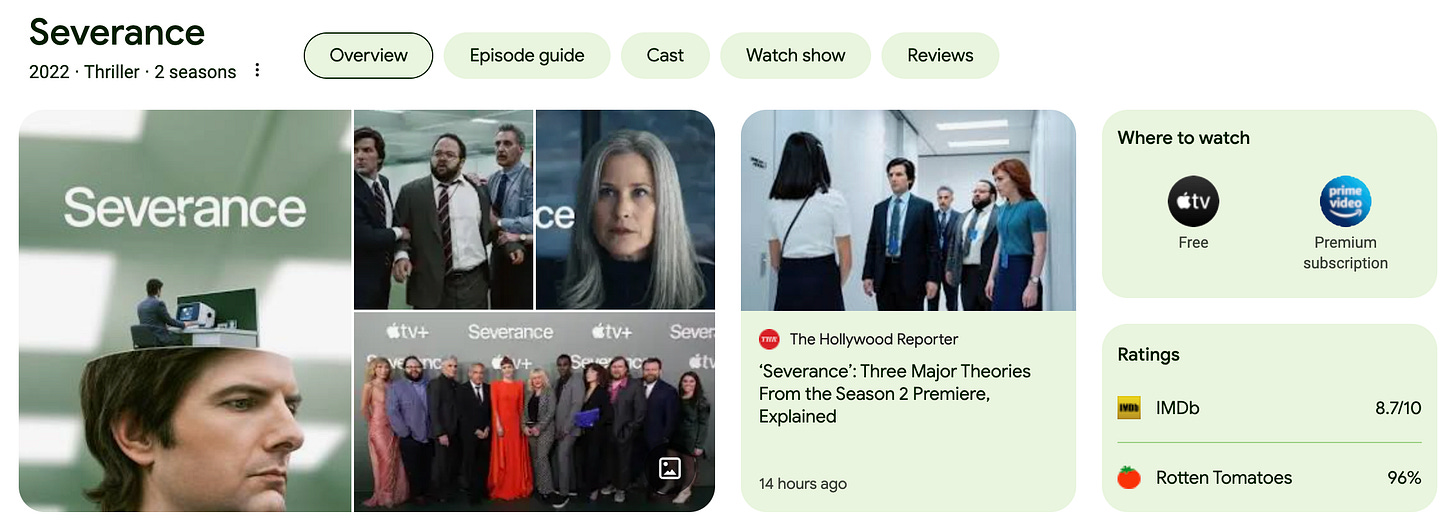Emotional Disengagement at Work Only Sort of Makes Sense
Many workers use apathy as a coping mechanism for a boring or pointless but needed job. Here's how to stay human at work--and how to help your team do the same.
Hey there, Mode/Switchers!
Watching Severance these days helps me notice two extremes of emotional (dis)engagement at work:
Severing work from life: This job’s good for my innie (professional self) but not for my outie (personal self). I’ll just get the “bullshit job” done but keep the boundaries tight.
Suturing work to life: Where would I be with out this job? I’m in debt to my eyeballs—or I need this for the next step in my career. Plus, if I weren’t busy with work, I’d have to deal with my sad, sad thoughts.
A therapist might call these strategies avoidant attachment and anxious attachment. But whatever their label, the strategies raise a question for us this week:
When you need your job AND you dislike your job, is it okay to emotionally detach, so long as you get your s%&t done?
(And after the Inauguration, I suppose we could ask the same thing about political attachments, too. This isn’t really that kind of newsletter, but it’s worth pondering.)
Let’s take up that question by skimming a trend, theory, story, and shift.
A TREND
Trade journalists have started using quasi-psychological descriptors for a spreading and stubborn workplace trend: they’re calling it “The Great Detachment.” WorkLife reports on the trend especially among younger professionals who despise a job they also need. Think of a 36-year-old whose rent is too high and whose college loans are still sky-high. At the same time, they dislike their job. It’s boring, it’s pointless, and it’s not clear why anybody’s doing it.
So, how do you cope when you need and hate your job? One strategy widely used today is to emotionally disengage. You keep a very low profile. You say very little. You keep every surface of your work-life as chill as possible.
A THEORY
According to corporate-therapeutic speak, employees are supposed to “bring their full selves to work.” But let’s try to grok why it’s hard to do that.
George Herbert Mead, the symbolic interactionist, would want to know which of our selves we’re supposed to bring. Every person’s identity, he would say, involves both an I and a Me. Think of your Me as the rule-keeping, boss-pleasing, sometimes even bootlicking part of you. Your I, contrarily, tends to be nonconformist, judgy, slant.
If you’re a manager with disengaged team members, it’s tempting (especially if you’re an Xer like me) to tell people to fake it till they make it. Come on guys, grow up, and get your personal I and your professional Me together.
But that approach doesn’t work very well. And here’s a cautionary tale why.
A STORY
One gorgeous September morning not far from New York City, some actors were working on Method Acting technique, when somebody burst into the studio and shouted, “A plane just hit one of the Twin Towers!” The actors jumped to what was for them a reasonable conclusion: This must be a theatre exercise! They immediately started responding to the scenario, taking on various postures of elaborate grief. One actor sank to the floor and sobbed. Another stood stock still and adopted a stunned look, her mouth hanging slack. A third ran around the room screaming.
Not too much later, someone else came into the studio and said, Hey, no guys, look, a pair of planes really did just hit the Towers. The performers stopped mid-motion, finally taking in the news, and then fully shut down all emotional expression.
That parable makes clear that the answer to this week’s question can’t be Method Acting. Emotional over-engagement’s no better than under-engagement. We can’t fake it till we make it any more than we can numb it till we’ve done it.1
For my book Digital Overwhelm, I talked with Gen Z and millennial professionals who more or less hid their feelings at work and reserved them for home. I understand this approach. I get why it feels necessary. But I honestly can’t recommend it. We spend way too much of our lives at work and—more importantly—way too much time with other humans, to emotionally check out.
So what makes sense to do? Is there a mode/switch worth making?
A SHIFT
What should the managers of emotionally engaged workers do?
Communicate the point of the work more clearly. Some sources blame the worker emotional detachment on a failure to communicate their vision, the company’s mission, and (quite simply) What It’s All About. If workers can’t see their work as significant, clearer communication of the company mission seems likely to help.
Give your team fewer digital platforms, not more. The reporting is clear here: you can’t tech your team to emotional authenticity. More digital connectivity results in more reactivity. (Plus, it’s worth asking whether the platforms you require are for your convenience or even your surveillance.) I know, I know, you’ve heard me say this too many times, but digital overwhelm’s a serious cause of worker deflation.
Share the meaning-making, distribute the choice-making. If you want your team to own the meaningfulness of your company’s work, you can’t just tell them what that is. They have to persuade themselves. And that will probably mean they need to help construct that meaningfulness in partnership with you. Ease up on the deadlines for a morning, send your remote team some DoorDash, or get together in the break room. Ask simple questions, What does this work mean? How does the world need us to do this? If it doesn’t, how can we change what we do, even a little?
What can emotionally disengaged employees do?
Let go of individualistic coping mechanisms. Emotionally detaching at work makes a certain sense—for you. Quiet quitting. Quiet vacationing. Quiet Whatever. They are all fairly justifiable choices. No judgment from me. But, look, those strategies are not sustainable. They’re about you and your feelings and your life. But your feelings and your life aren’t just about your feelings and your life. They’re embedded in spaces with the feelings and lives of others. Emotional detachment strategies leave poor workplace conditions static. And they leave your coworkers out in the cold.
Instead of deflecting or selecting or projecting, try connecting. Deflecting is what the emotionally engaged do most often. Nah. I’m fine. Let’s just get through this day. Selecting means you sovereignly decide that this part of your life matters and that part doesn’t. My real life is after the 9 to 5. And projecting is what you do when you attribute only ill motives to your boss or your coworkers—It’s all about the _____ for them—and then use those projected motives to justify your detachment.
Instead, try connecting. Look, humans gotta human: you’re a meaning-making creature. You can’t help it. And when you just shut that meaning-making and connection-making down, you become less than the human you want to be. Really, this comes to down to a lot of questioning. Ask about connections between your tasks and the life of your org. Or about the work of your org and the vitality of its neighborhood. Or the vitality of neighborhood and even larger circles of relation. The connections won’t be obvious. You’ll have to keep asking about them, keep looking for them.
Emotional disengagement’s a tough problem, because it makes so much sense. I hope it’s clear that I don’t just mean for managers to turn into clinical therapists. Or, if you’re a worker, to turn yourself into a TMI patient, treating everybody else on your team like a shrink to whom you divulge your deepest secrets. My advice isn’t so much about how much you emotionally disclose as about how emotionally show up. Being there, being connected, being awake in the work, for the client, with the team.
Ask yourself, and keep asking your coworkers, what’s this job connected to? What networks do its products and services affect? What relationships are already present and could be cultivated? What’s the job doing to the physical world around us?
Maybe, there are few immediate answers to those questions. That’s why you’re asking! But connection-making can help make clear the nonobvious meanings of your toil.
-craig
Whassup with Mode/Switch Premium?
This free Tuesday newsletter’s not going away, nor is the Thursday podcast. (See last week’s convo about workplace mentorship with psychologist Dr. Deborah Heiser.) We’re gonna keep right on making sense of American work culture!
Buuuuuuut there’s another way for you and me to connect! Join Mode/Switch Premium and post-op Severance, Season 2 with me, episode by episode, each Saturday morning. Sign up by clicking on this link—or just hitting “Upgrade to Paid.” For $5/month, access is all yours.
You’re watching the show, right? (Or you’re curious about it.) Why not use that time to do some meaning-making and connection-making for yourself and your working community?
I learned this parable from Thomas de Zengotita’s book Mediated.





